Unlock the potential of SMS marketing with 10 popular use cases and examples, showcasing how marketers effectively engage customers through text messages.
December 4, 2023
Text Marketing Examples: Boosting Sales with Engaging SMS Campaigns
SMS messages are read more often than other types of broadcasts. According to a study by the SHIFT agency, four out of five smartphone owners read every SMS they receive.
We’ve compiled essential strategies for creating effective SMS campaigns along with 10 use cases to showcase these strategies in action. These principles are designed to guide you in crafting messages that are both engaging and subtle, driving your customers towards making purchases. The insights and text campaign examples in this article are derived from the experiences of Maestra’s clients, leading marketing experts, content marketers, and editors, as well as studies from prominent messaging services and agencies.
What is Text Marketing?
Text marketing, also known as SMS marketing, is a strategy that involves sending promotional or transactional messages for marketing purposes using text messages (SMS). This form of marketing reaches customers directly on their mobile phones and is typically used to announce special deals, updates, reminders, and more. The power of text marketing lies in its immediacy and personal reach — messages land straight into the hands of consumers, often resulting in higher engagement rates compared to other digital marketing channels. It’s a direct approach to communication that allows businesses to connect with their audience in real-time, offering a personal touch that can significantly boost customer interaction and sales.
10 SMS Marketing Use Cases
Here are a few of the most common examples of use cases for text message campaigns:
1. Time-Limited Offers
Text messages quickly reach customers to advertise limited-time offers and promotions (for example, flash sales) capitalizing on the urgency to drive immediate action. This tactic is especially effective due to the high open rates of text messages, ensuring that your time-sensitive deals are seen promptly by a wide audience.
2. Surveys and Feedback
Using SMS campaigns for surveys and feedback is highly efficient, given the ease with which customers can respond. This approach not only increases text message engagement but also provides businesses with quick and actionable marketing insights into customer preferences and experiences — for example, gauging the level of satisfaction with the quality of customer service.
3. Birthday Messages
Personalized birthday greetings sent via SMS add a special touch to customer relationships. These messages can be coupled with exclusive offers or discounts, enhancing customer loyalty.
4. Welcome Texts
Welcome SMS campaigns are designed to onboard new customers, introducing them to the brand’s ethos. These messages often include exclusive offers for newcomers and other important info such as app download links and loyalty program details. The primary goal is to engage new customers right from their first interaction, providing them with valuable insights and incentives to encourage immediate and ongoing engagement with the brand.
5. Reactivation Texts
Reengagement communications are targeted efforts to reconnect with customers who have become less active. These SMS messages typically feature updates or exclusive offers that are relevant to the customer’s previous interests, aiming at reigniting their engagement with the brand. The focus is on delivering personalized content that demonstrates the brand’s continued relevance to the customer’s needs and preferences.
6. Abandoned Cart Reminders
Reminding customers of their abandoned carts through SMS is a straightforward yet powerful way to boost conversions. These reminders are often integrated into a broader marketing flow, typically beginning with email campaigns. SMS campaigns, being a more costly channel, are then utilized if the email efforts are unsuccessful. Timely follow-ups, perhaps a day after the initial email, leverage the immediacy of SMS to engage customers who may have overlooked earlier emails.
Additionally, abandoned cart texts can be personalized based on the customer’s cart contents, making them more relevant and persuasive — which brings us on to the next use case.
7. Personalized Offers
By analyzing customer purchase history and preferences, businesses can send highly tailored SMS campaigns featuring promo codes, exclusive discounts, or special deals on products that individual customers have shown interest in or bought frequently. This strategy goes beyond generic marketing, as it speaks directly to each customer’s interests and needs.
For example, a customer who frequently purchases skincare products from a particular brand might receive an SMS with a special offer on products from this brand or a notification letting them know this brand is on sale. This fosters a sense of being understood and valued by the brand, increasing the likelihood of a sale and fostering long-term loyalty.
8. Delivery Updates
Providing timely updates about deliveries via SMS enhances customer service by keeping customers engaged with their order’s journey. These updates typically include convenient links to order tracking on the carrier’s website, accompanied by key updates during the package’s transit — for example, alerts on delivery details such as the expected delivery day and approximate time. Delivery updates not only keep recipients informed but also reduce the frequency of customer service inquiries about order statuses. This is a great approach in ensuring a positive post-purchase experience.
9. Appointment Reminders
SMS appointment reminders are an effective tool for reducing no-shows and enhancing customer engagement. These messages are particularly valuable in sectors where appointment adherence is vital, such as healthcare and service industries, providing customers with essential details like the date, time, and location of their appointment, along with options for rescheduling if necessary. This method not only reminds customers of their commitments but also helps businesses optimize their schedules and reduce lost time.
10. Lead Nurturing
SMS can be an effective, direct, and personal way to nurture leads, often achieving greater engagement compared to email-based strategies. However, it’s important to approach this method with sensitivity. Communications via SMS should be carefully targeted, ensuring they are welcome and relevant to the audience. This strategy is particularly effective when focusing on leads who have demonstrated a higher level of interest or interaction with your brand, as they are more likely to appreciate and respond to direct SMS communications.
Text Message Marketing Best Practices and Examples
Make Specific Offers
Effective SMS marketing hinges on delivering messages that are clear and to the point, respecting the user’s time. The goal is to convey the core offer or benefit within the first few words of the message.
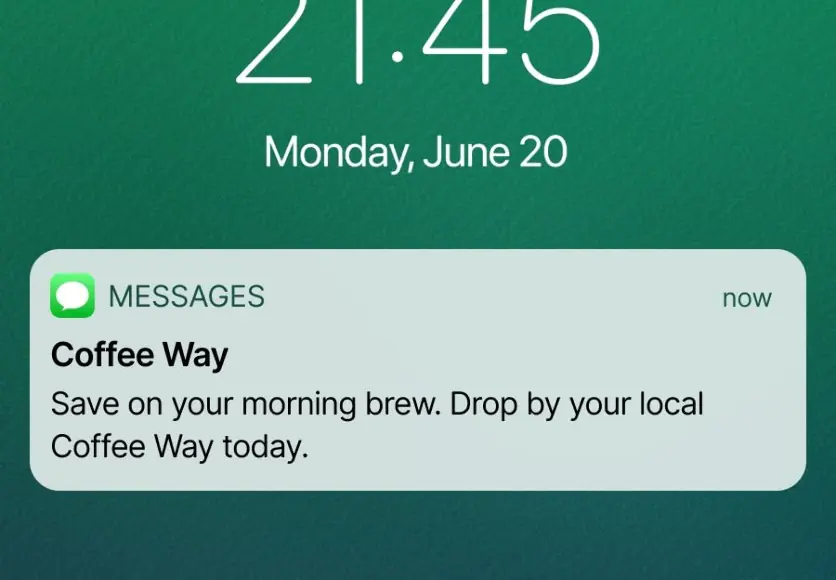
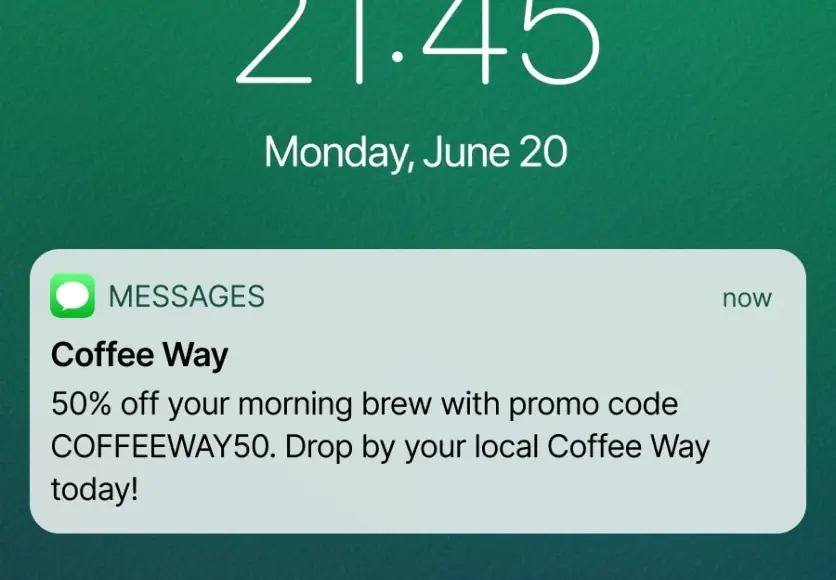
❌ This SMS campaign contains a vague offer — customers are not informed how much they can save and will have to visit the coffee shop to find out
✅ This text message contains an example of a clear, direct offer that customers immediately understand how to utilize
Data from EZ Texting reveals that 54% of customers prefer receiving SMS messages that include promotional deals. Salesforce’s findings also support this, showing that 77% of customers sign up for messages to get coupons or special deals. These statistics underline the importance of direct offers in SMS marketing.
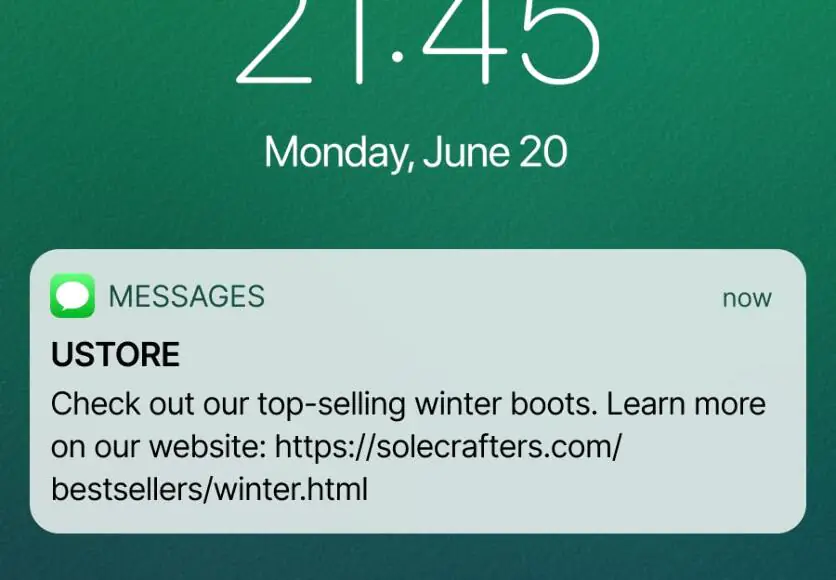
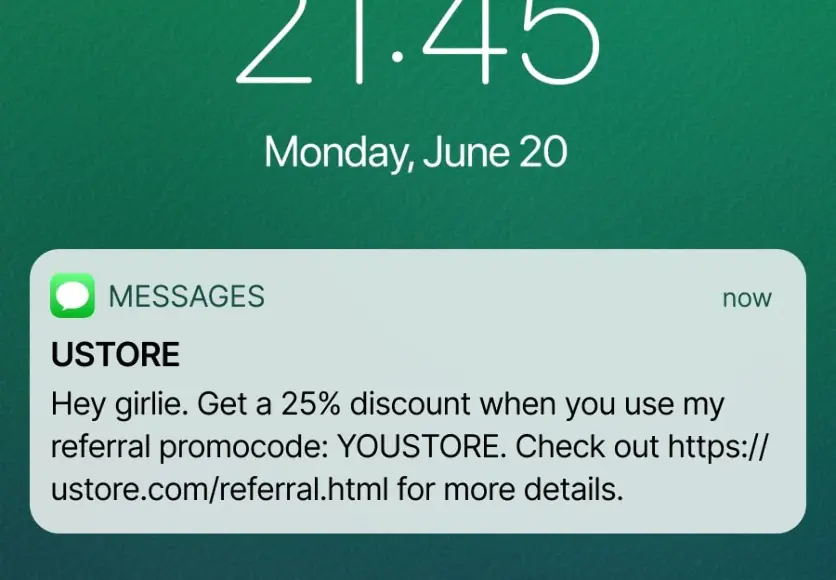
❌ No actual offer in this example — this text message is simply informational. Might only appeal to someone actively searching for winter footwear
✅ The promise of a discount captures attention, making the message more enticing to open
PRO TIP:
A successful SMS campaign starts by addressing the customer’s pain point, making it immediately clear that the message is relevant to them. It should then concisely present the essence of the offer without unnecessary details, followed by a call to action.
A successful SMS campaign starts by addressing the customer’s pain point, making it immediately clear that the message is relevant to them. It should then concisely present the essence of the offer without unnecessary details, followed by a call to action.
Avoid Using Too Many Capital Letters and Emojis
The core guidelines here can be summarized as follows:
- Refrain from using all caps in your SMS messages, as this can create a negative impression. Text in all uppercase can sometimes be interpreted as visual shouting.
- Limit the use of exclamation and question marks to avoid making the text seem overly desperate or aggressive.
- Use emojis sparingly in messages
Through A/B testing, fashion retailer 12 STOREEZ confirmed that emails without emojis in the subject line tend to have better open rates. This might be because such emails are less likely to be perceived as spam and may appear more important to subscribers. While this doesn’t necessarily mean that emojis in SMS function the same as in email marketing, this experience can provide valuable guidance when creating SMS campaigns.
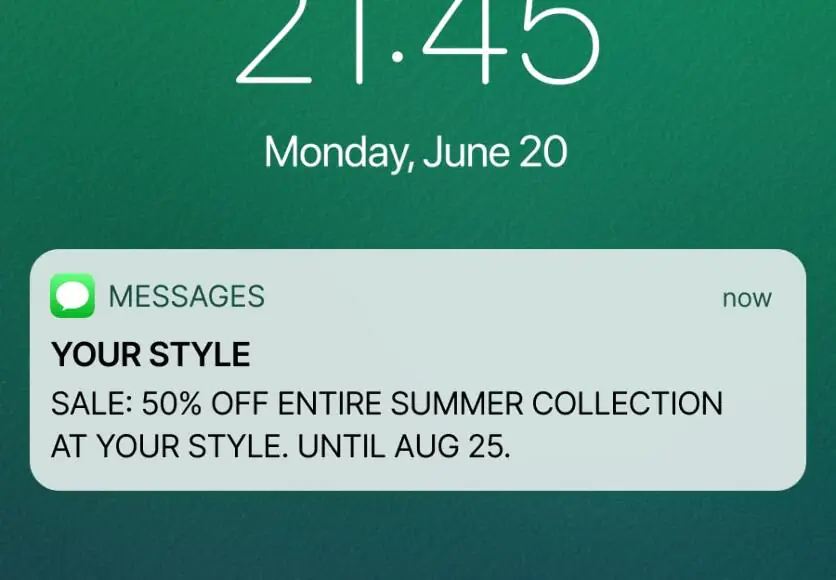
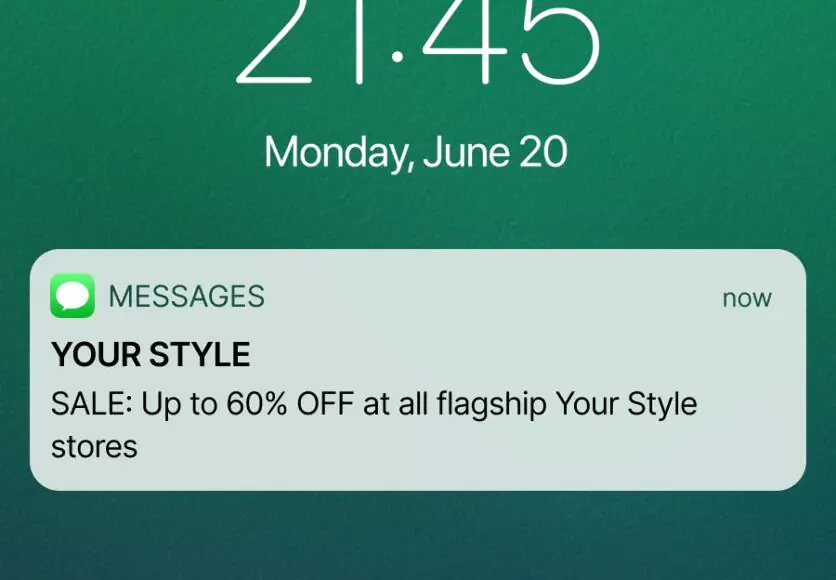
❌ This text message example demonstrates how a campaign in all capital letters can look somewhat aggressive, as though it’s shouting at the recipient
✅ A text for an SMS marketing campaign that contains examples of effective use of capital letters to highlight important details
Choose the Right Day and Time
According to our statistics at Maestra, the peak average click rates for SMS campaigns are typically between 12:00 PM and 3:00 PM. The most responsive days for such broadcasts are Sunday and Monday. Additionally, according to Textmagic, the timing of event-related SMS messages is crucial — sending them closer to the actual event time is more effective, leveraging the immediacy with which SMS are read.
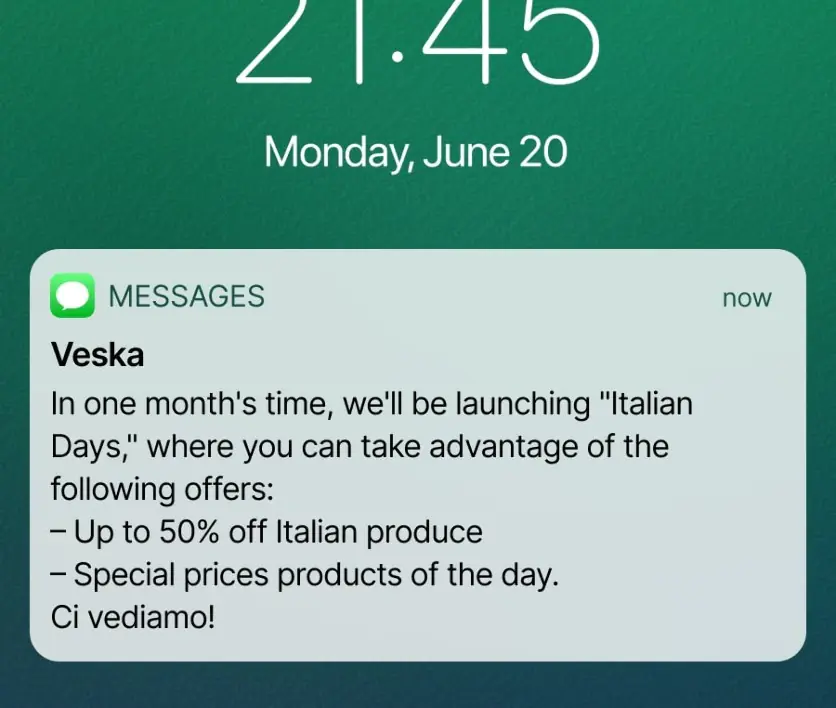
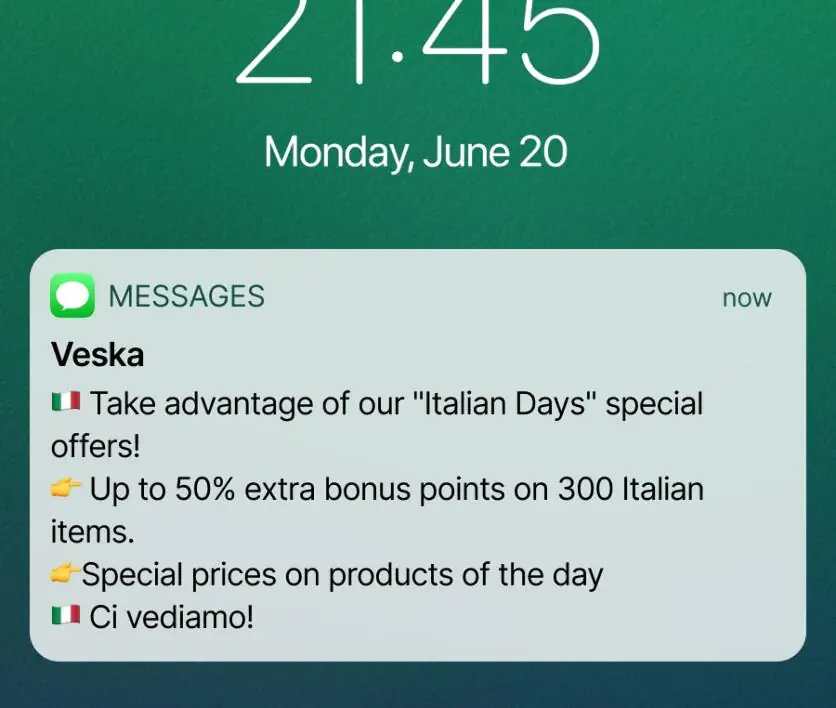
❌ This SMS marketing campaign risks being forgotten — in this example, the text is sent a month in advance
✅ In this example, the text message about Italian Days is sent during the event for timely relevance
Avoid Sending SMS Campaigns Every Day
Monitoring the frequency of SMS sends is key for maintaining a balanced marketing budget and preserving customer loyalty. Overuse of SMS can easily lead to negative reactions. According to a report by SimpleTexting, the main reason customers unsubscribe from SMS broadcasts is due to companies reminding them of their presence too often. When asked about their preferred frequency for receiving company text campaigns, 56% of customers favored once every two weeks, 29% preferred once a week, and only 2.3% were comfortable with four times a week. Importantly, 59.5% of customers reported that too many text messages from a business is the most likely factor to make them unsubscribe.

Excerpt from SimpleTexting’s report
PRO TIP:
Reserve mass text message campaigns for significant events — like advertising a Cyber Monday sale, for example. This will help you make more of an impact without overburdening your audience, allowing you to maintain customer interest and engagement without crossing into intrusion.
Reserve mass text message campaigns for significant events — like advertising a Cyber Monday sale, for example. This will help you make more of an impact without overburdening your audience, allowing you to maintain customer interest and engagement without crossing into intrusion.
Create Urgency with Time-Limited Offers
According to research by Messente, customers tend to find offers that are always available less appealing. Conversely, indicating that an offer will soon expire creates a sense of urgency and leads to quicker responses from buyers. This strategy taps into the psychological principle of scarcity, making the offer seem more valuable because it is time-sensitive.
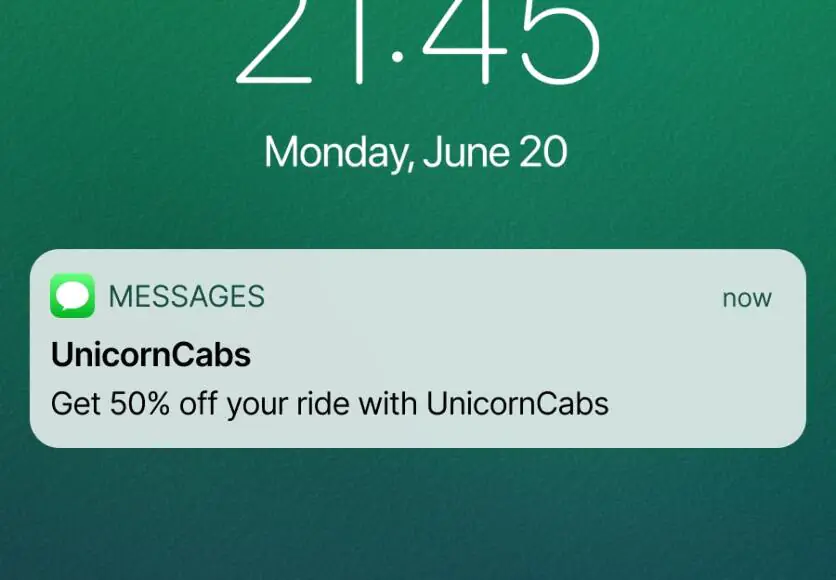
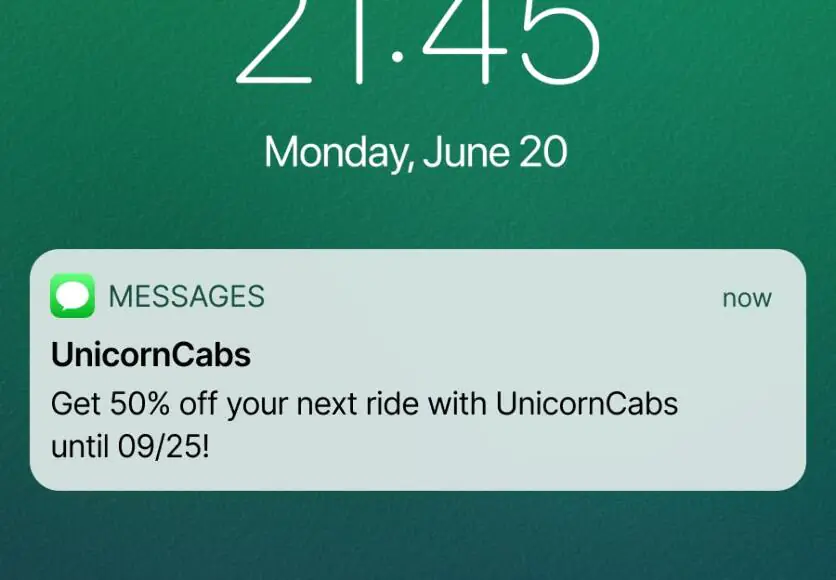
❌ This example of a text message campaign without a time limit may appear less interesting, lacking a sense of urgency
✅ In this example, the SMS marketing text features a time-limited offer
Include Sender Name, Phone Number, and Website Links
It might seem logical to omit the sender’s name and contact details to save on SMS characters. However, Messente’s research indicates that people tend to ignore messages from unknown sources, often perceiving anonymous texts as spam, highlighting the importance of establishing trust and credibility in your SMS campaigns.
In addition, findings from EZ Texting’s report demonstrate that:
- 29% of customers who opted in for SMS marketing messages click on links.
- 47% of those who click on links to a business website make a purchase.
This demonstrates that while brevity is key in text messaging, including sender information and relevant links is crucial for trust and engagement.
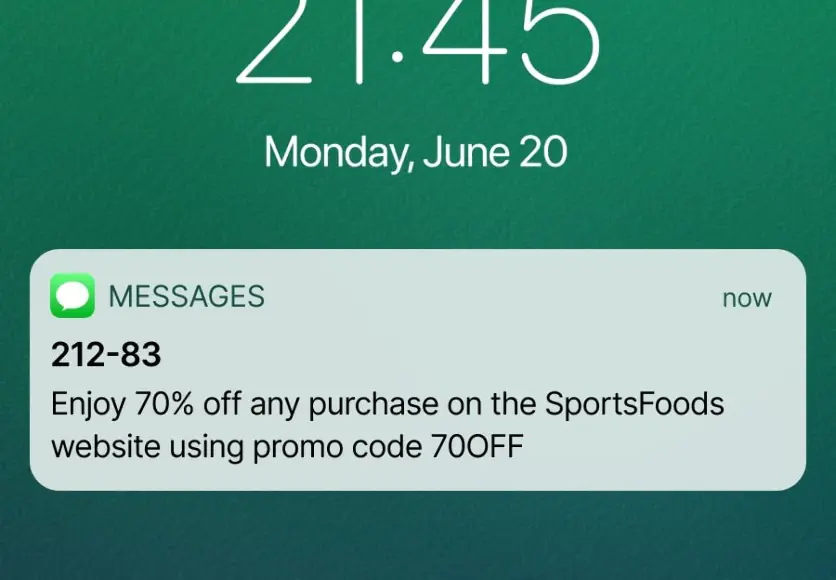
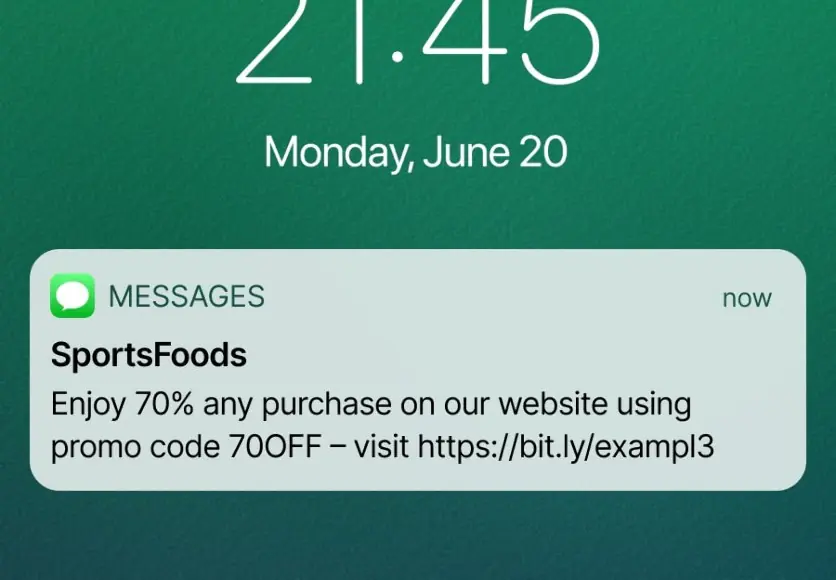
❌ The customer does not immediately understand who this message is from as there there is no sender name, causing potential distrust. Once they have read the message and recognized the sender, they will have to manually enter SportsFood’s website address and search for offer details
✅ In this text message example, the sender name is instantly recognizable, creating more trust. The direct link in the text takes customers straight to the offer, simplifying the shopping process and enhancing the user experience
Incorporate a Strong Call to Action
Calls to action (CTAs) like "Register Now," "Send a Message," or "Reveal Promo Code" significantly enhance the likelihood of conversion. Textmagic’s data suggests that without a clear CTA, there’s a high chance a customer will ignore the message, even if they find the content interesting.
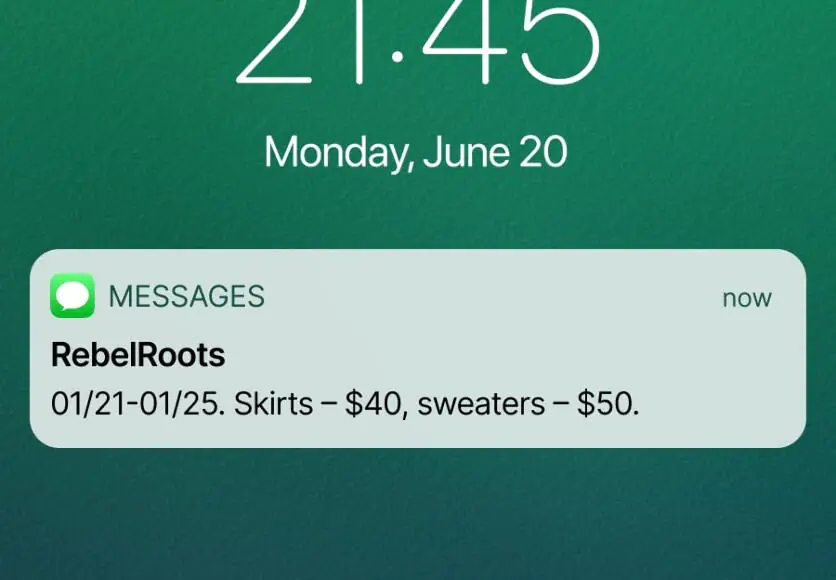
❌ In this example, the text message lacks clarity about its intention and what is expected of the customer
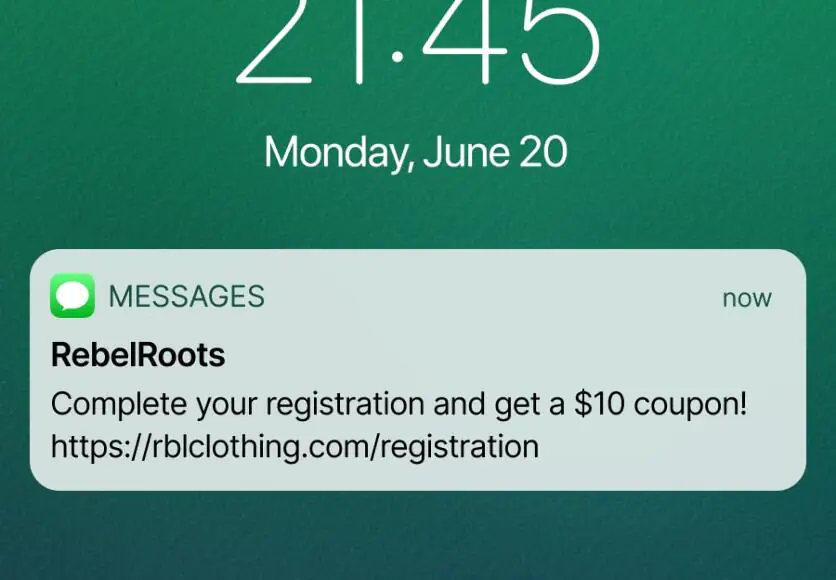
✅ This SMS contains a straightforward call to action and a direct link for immediate action
Personalize SMS Campaigns
According to Salesforce, 73% of customers expect companies to understand their needs and expectations. Additionally, 62% believe that companies should tailor their approach to individual customer needs. Effective SMS campaigns are personalized — they include the customer’s name and take into account their interests and preferences.
Personalization not only meets customer expectations but also optimizes marketing budgets by targeting only those likely to be interested.
Companies using Maestra approach personalization in SMS marketing through:
- Customizing SMS content with the recipient’s name, relevant order details, or specific products in their shopping cart, including item names, prices, and discount amounts.
- Segmenting the target audience for SMS campaigns based on their engagement level and interests, creating groups like "Recently Registered," "Loyal Customers," "Sale Enthusiasts," "Churn Risk."
- Merging customer data across various channels into a unified profile, ensuring that a customer does not receive the same message twice.
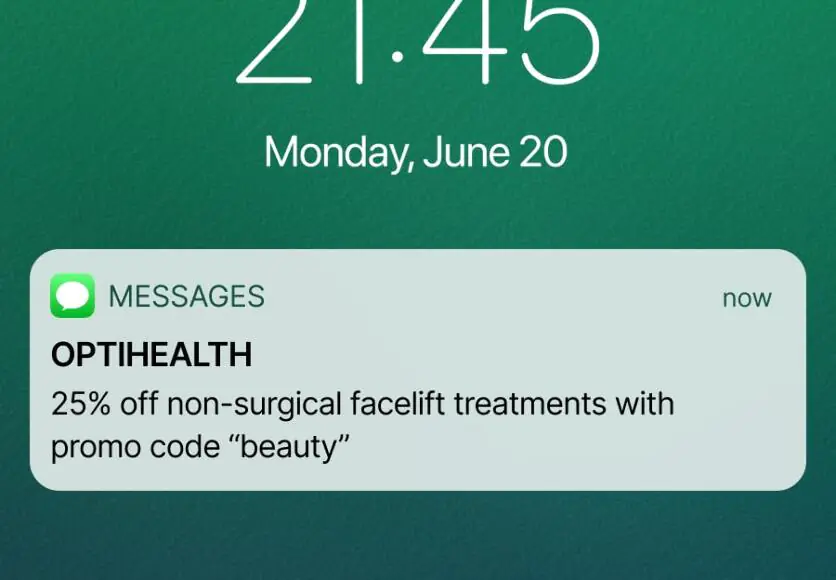
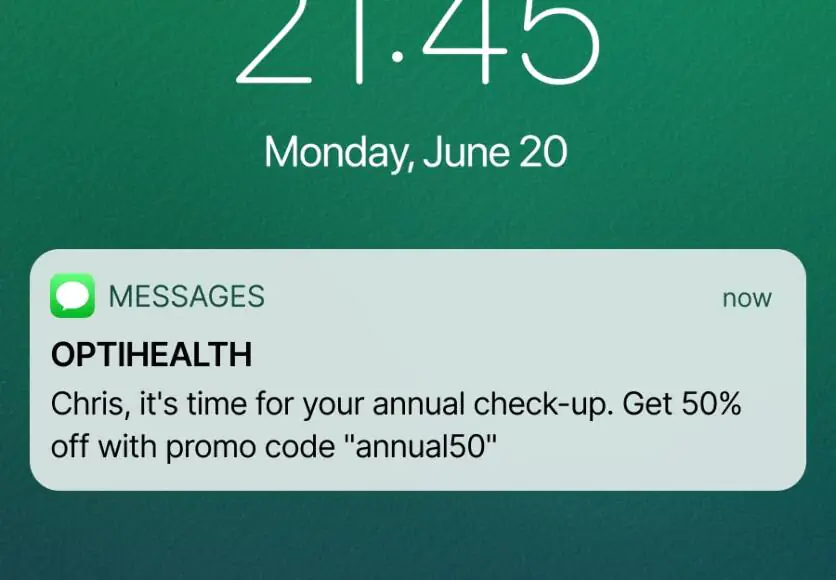
❌ In this example, the clinic has sent a generic text messages that does not reflect the individual interests of the customer, resulting in irrelevant communication
✅ This campaign addresses the customer by name and reminds them about their annual check-up one year after their previous check-up
Get Creative with Your Special Offers
Simpletexting’s guide suggests maintaining customer interest through a variety of offers. This can include a discount one week, a promo code the next, followed by an engaging advertisement. This variety not only keeps the content fresh and engaging, but also piques the curiosity of your customers, encouraging them to look forward to your messages.
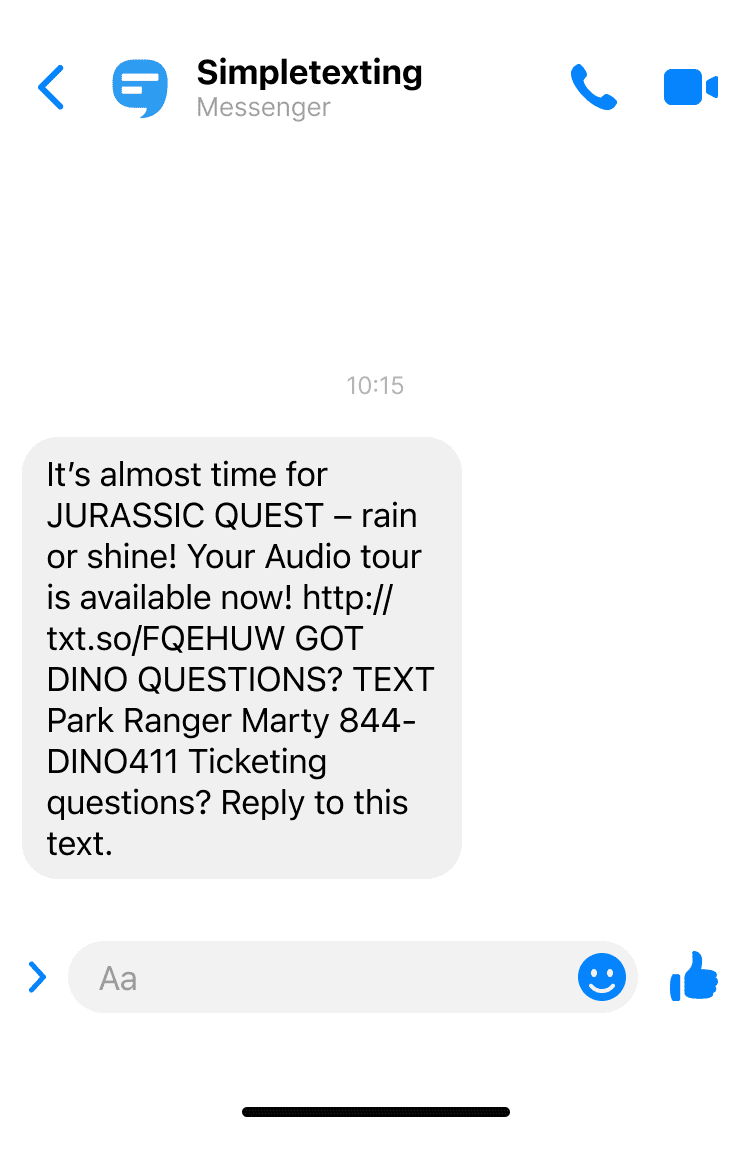
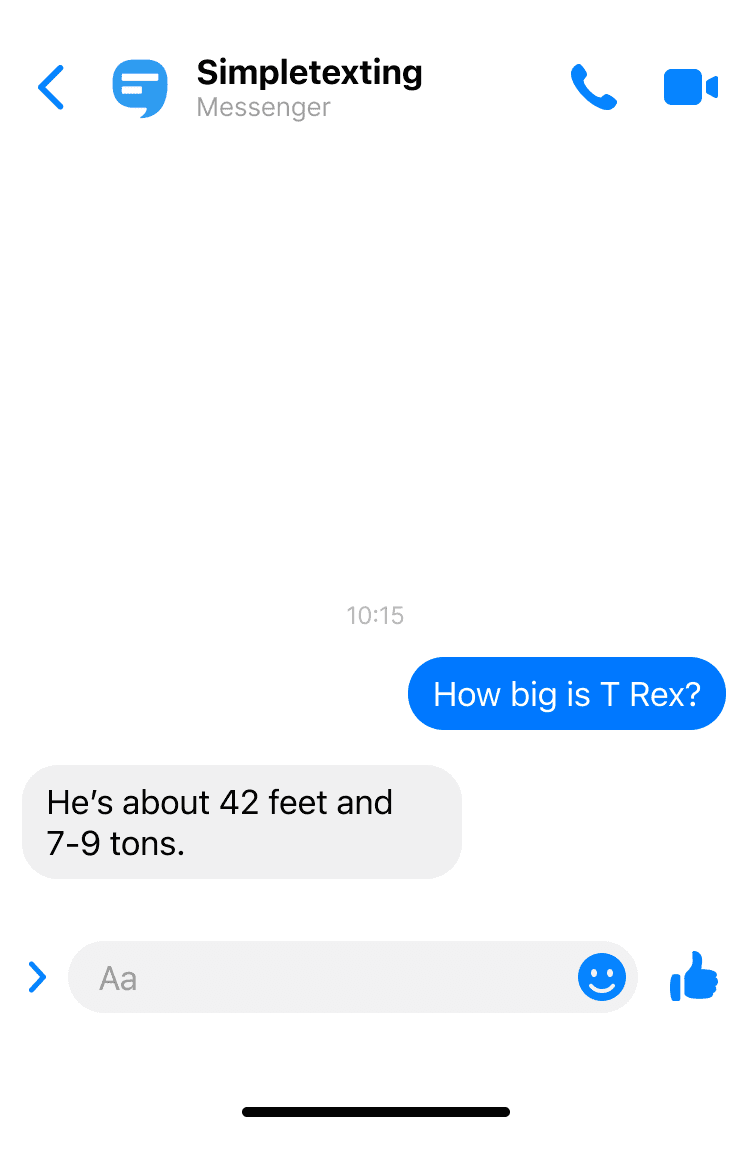
Jurassic Quest, a mobile dinosaur exhibit, combines exhibition invitations with additional engaging content in their campaigns. They include links to an audio guide and address questions about dinosaurs, achieving an impressive 98% click-through rate on their SMS links
Keep SMS Messages Within a 160-Character Limit
The maximum length of a standard SMS is 160 characters including spaces and if your message contains a Unicode character, this is reduced to 70 characters. Exceeding this count leads to the message being split and potentially incurring additional costs. Writing concise messages not only helps manage these costs but also ensures the message is clear and direct.
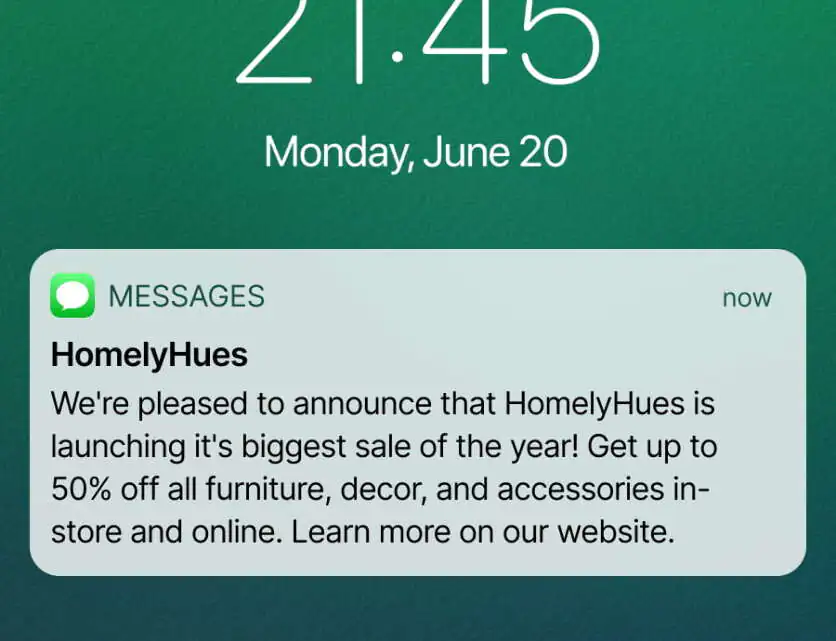
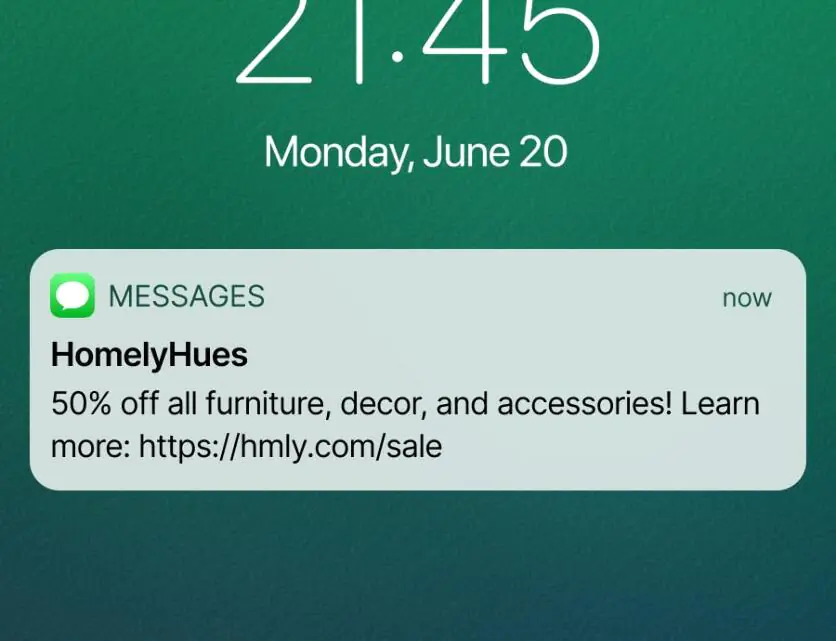
❌ A lengthy SMS campaign that could be more cost-effective and impactful if shortened
✅ An example of a short and concise text message
Text messaging services often include character counters to help manage the length of your messages, ensuring they stay within the one-SMS limit:
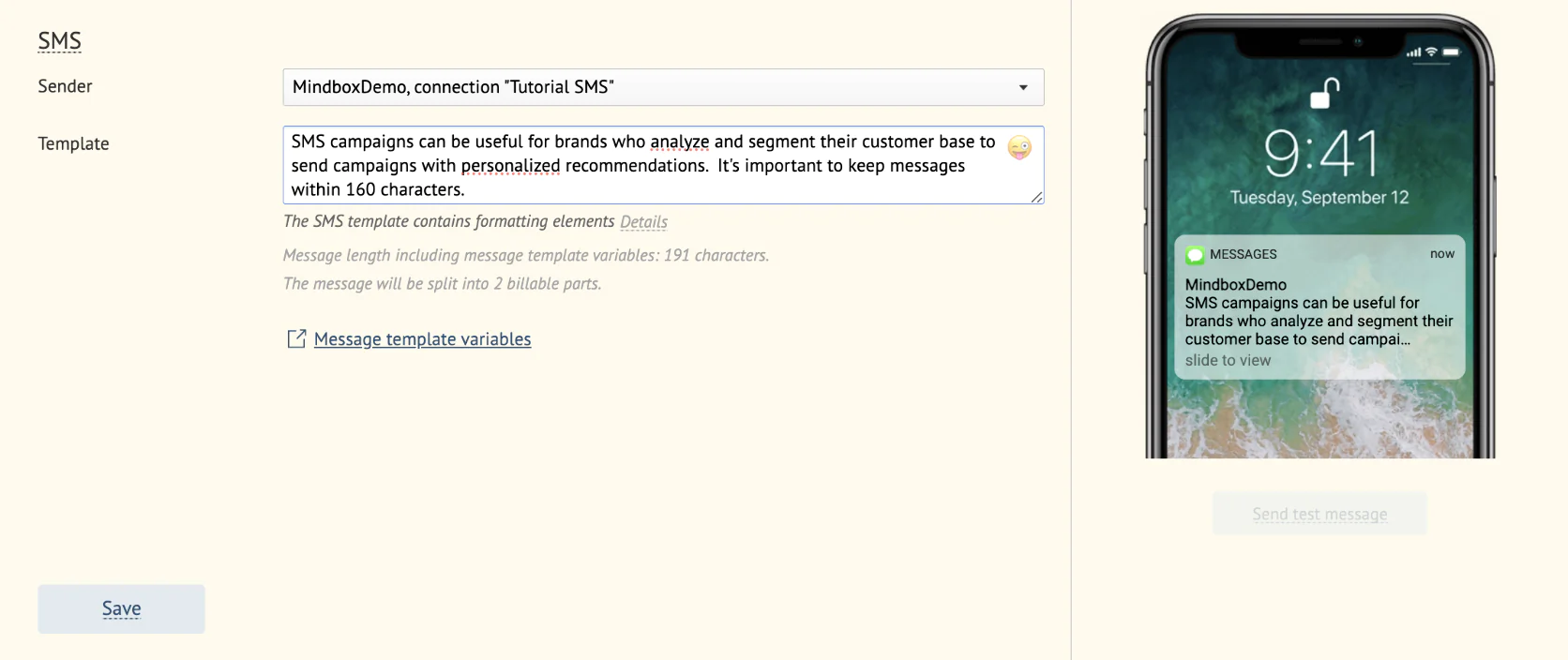
Maestra’s SMS campaign builder displays the character count to help optimize message length
Crafting an Effective Text Campaign
In conclusion, a good general formula for any SMS campaign is:

An effective text campaign requires you combine a clear value proposition, a persuasive call to action, and the strategic use of urgency. There is no “perfect” formula for a high-converting campaign, however, you can discover what works best for your customers through meticulous testing and adaptation. Before committing substantial resources to SMS marketing, consider testing different approaches via your email campaigns to refine your strategy. With each test, you fine-tune your understanding of what resonates with your audience, paving the way for a text campaign that not only captures attention but also converts.
